Admit it: you're always drawn to them. It's their height…their interesting contrast…those smoky good looks. This month in Smart Gardener we look at the tall and deeply colored plants that are fast becoming a signature in modern gardens.
Deep, rich color gives gardeners the dark side of contrast that can be hard to achieve with green-foliaged plants. Tall, dark plants become a backdrop for everything else in the garden: their purple-to-black foliage makes chartreuse plants pop, while upping the elegance of silver- and blue-toned annuals and perennials. All flower colors are more dramatic around a dark-leaved partner—especially flowers with a hint of deep purple in them, like the many lilies sprinkled with dark spots.
While "back of the border" was once considered the appropriate placement for tall plants, they need not be relegated to a line-up against the wall. On your next summer visit, keep an eye out for the many different ways that horticulturists are using tall, dark plants throughout the Garden—as individual specimens in containers, as backgrounds for plants with more delicate detailing, or as exclamation points and anchors in larger beds and borders.
Tall, Dark, and Elegant
Right at the entrance, at the beds outside the Visitor Center, we greet you with a tall, dark beauty: Pennisetum purpureum 'Prince, an elephant grass with deep bronze coloring on its long, strappy leaves. A grass that grows into an elegant, 3-foot mound, 'Prince' is hardy in zones 8 to 10, but not in our area. Planted as an annual or overwintered in a container, it's a worthy investment.
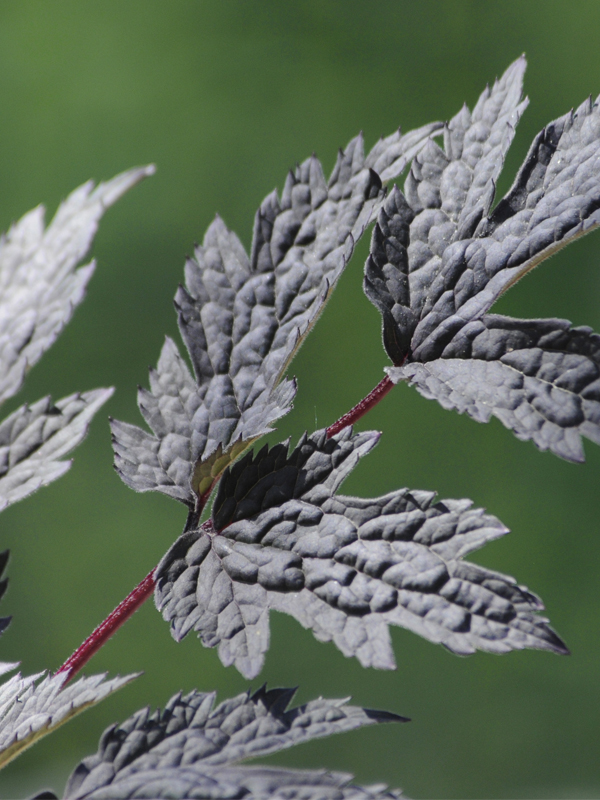
Actaea simplex 'Hillside Black Beauty'
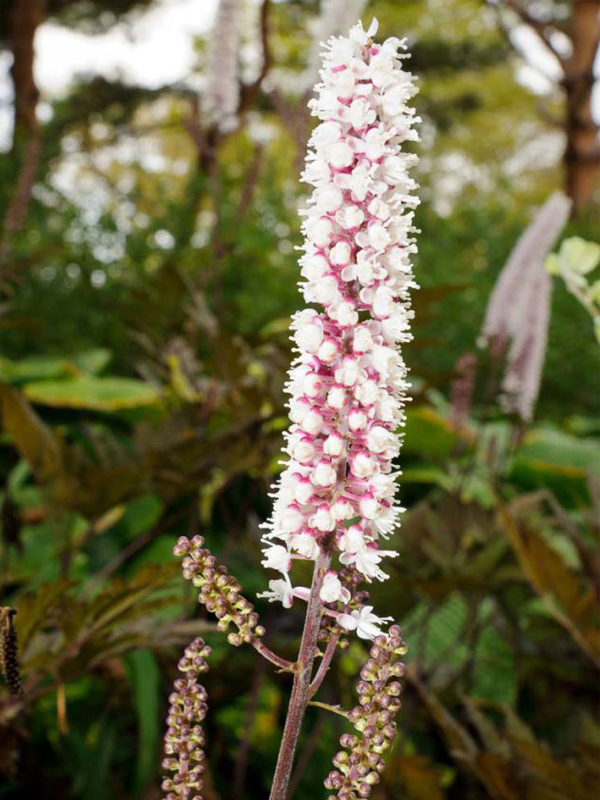
Actaea simplex 'Brunette'
Tall, Dark, and Shady
Names like 'Hillside Black Beauty', 'Black Negligee' and 'Brunette' give you a better mental image of Actea simplex than its common name—black bugbane—does. (Although that's a telltale name, too: bugbane naturally repels deer.)
At the top of the Sensory Garden, 'Brunette' reveals its tall spikes of flowers, purple-tinged foliage, and nicely airy texture. On the shady woodland path below, a new patch of baby bugbane 'Hillside Black Beauty' has just been planted—watch it fill in quickly in the shaded, moist conditions that bugbane loves. Terrific garden perennials for wooded and shaded yards, bugbanes stand about 3 feet tall, stretching up to 5 feet when spikes flower (from September to October).
Tall, Dark, and "Tropical"
Stopped in your tracks by dinner-plate-sized, tropical-looking flowers in your neighbor's yard? Chances are it's a rose mallow (Hibiscus moscheutos). In our northern climate, rose mallows are hardy perennial plants that emerge early in summer and bloom early in fall, topping out at 4 to 5 feet—compact, compared to their tropical cousins. Varieties with dark purple foliage are especially dramatic, as their white, pink, or deep rose flowers stand out powerfully against the maple-like leaves.
Naturally, hibiscus need full sun, and they prefer moister soils. For an only-at-the-Garden experience, head out to the Bernice E. Lavin Plant Evaluation Garden to see a bevy of hibiscus varieties currently being assessed, including 'Summer Storm' (pink flowers) and 'Midnight Marvel' (bright red blooms). Another dozen not-dark-but-still-wonderful varieties are listed in our Plant Finder—see sidebar for details.
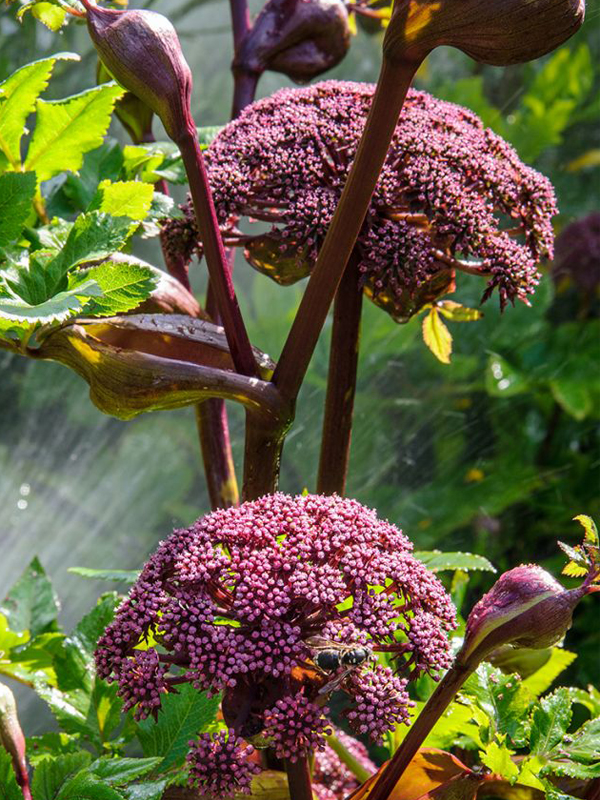
Angelica gigas
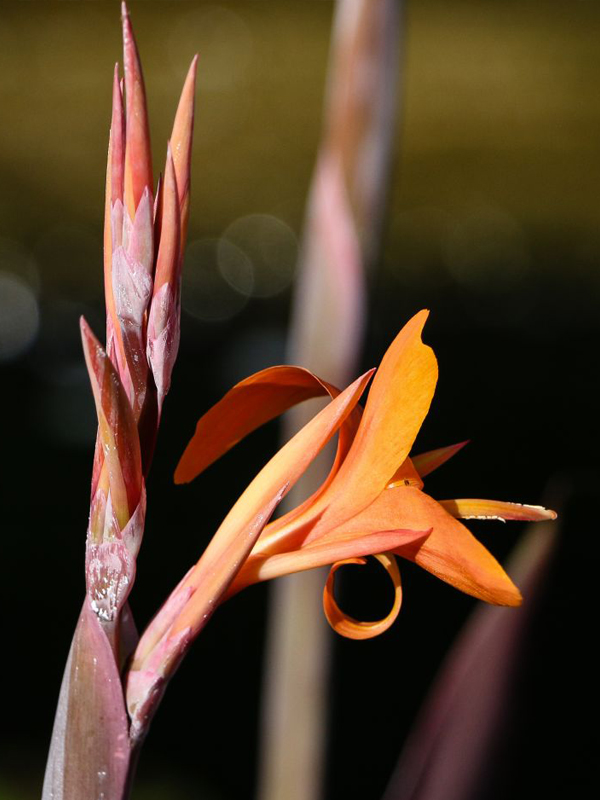
Canna 'Intrigue' are sure to get noticed.
Tall, Dark, and Bold
A "what is that?" plant to be sure, Giant Angelica (Angelica gigas) starts the year out with big-as-your-hand green leaves, then powers up in late summer with 6-foot-tall, dark purple stems and buds that explode into giant, plum-colored flower umbels. In full sun or partial shade, this dynamic plant attracts butterflies as easily as it does a neighbor's interest. You'll have to plant it every 3 to 4 years, although they often self-sow. Single specimens can be found in the Heritage Garden, with larger patches of the native (all-green) Angelica atropurpurea standing tall at the Trellis Bridge on the Evening Island side.
Tall, Dark, and "It"
Smart Gardener readers will recall that our April edition focused on the 2015 "it" color of the year, marsala, as designated by the Pantone Color Institute®. Now's your chance to see the container plants we talked about then in all their glory on the north steps of the Regenstein Center. While marsala can manifest as a pink-to-rosy hue, it also has its darker side.
The canna lily cultivar 'Intrigue', for example, has the tall, swordlike, deep maroon leaves that can anchor a large container or water feature. The water canna is a non-hardy, tuberous perennial that we've used in the Heritage Garden fountain plantings, too. Its orange flower comes as a vivid surprise.
The tallest plant on the steps may be familiar: it's a Bloodgood Japanese maple (Acer palmatum 'Bloodgood')—see sidebar for details. Many Chicago area gardeners have already experimented with this small tree as a dark accent and anchor. Looking for a more unusual variety? Walk toward the Model Railroad Garden, where 'Hefner's Red,' stands around the corner from the entrance. Its starry leaves and brighter red color are especially wonderful in fall—but note that it's more tender than 'Bloodgood,' so treat it with extra TLC in a well-protected area of the yard. It's a bit smaller (18 feet) than 'Bloodgood' (20 feet), too.

Physocarpus opulifolius 'Monlo'
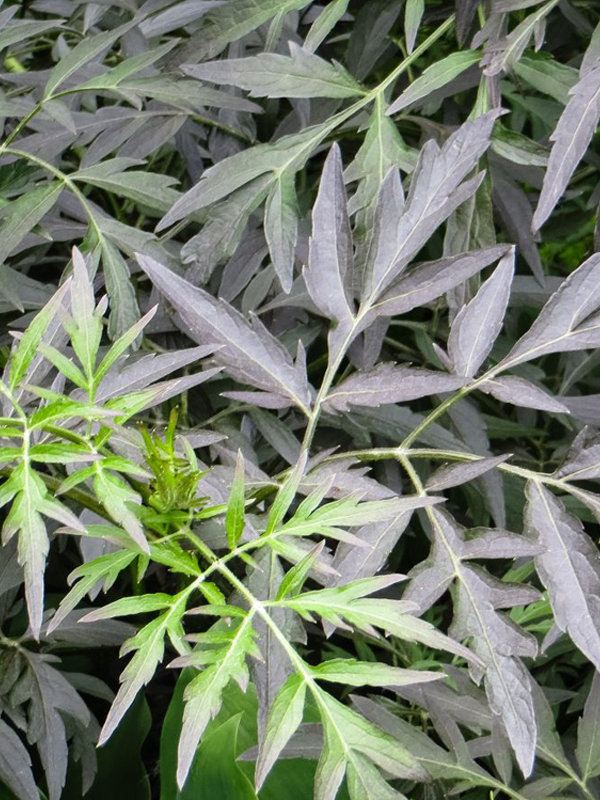
Sambucus nigra 'Eva'
Tall, Dark, and Shrubby
A well-placed shrub may be all the dark color you need in a border. Two to consider: Diablo® Eastern ninebark (Physocarpus opulifolius 'Monlo') and Black Lace™ European elderberry (Sambucus nigra 'Eva')—see our sidebar for photos.
Ninebark is an underused shrub with lots of terrific qualities: hardy and easy to grow, with interesting bark in winter, pink-white flowers early in the summer, and a habit of attracting butterflies. Diablo® has gorgeous, dark bronze foliage that suggests all sorts of design options; look for full-grown, 8- to 10-foot examples outside of the round-windowed "pepper pots" at the English Walled Garden.
Like ninebark, Black Lace™ European elderberry thrives in full sun, although it can take a bit of shade, too. Tall (up to 8 feet), super hardy and a magnet for butterflies and birds (they love the fruit), imagine elderberry as a dark screen or hedge, as well as a single specimen. Very dark, lacy foliage is a dramatic background for lovely pink flowers.
Tall, Dark, and Airy
One of the easiest tall and dark plants to grow, bronze fennel can be sown from seed. Its dark and delicate, wispy foliage can be used to great effect in the border. An herb fennel, rather than a bulb fennel, Foeniculum vulgare var. dulce 'Rubra' has fragrant, bronze-red leaves atop 4- to 6-foot stems. A bonus: both leaves and stems are edible. Note that it will re-seed freely!
Karen Zaworski is a garden writer and photographer who lives and gardens in Oak Park, Illinois.

